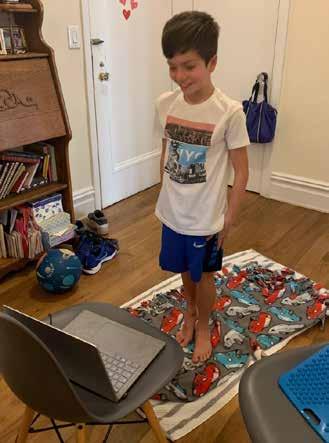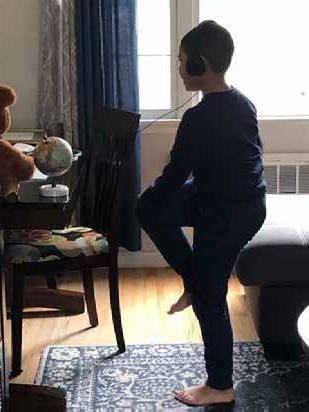
2 minute read
Movement-Based Therapy
DYNAMIC MOVEMENT-BASED THERAPY DURING THE PANDEMIC
As occupational therapists, we know professionally and personally the power of movement to calm, to alert and to soothe anxious spirits. In the time of COVID-19, with the additional stressors of at-home learning, a new and unfamiliar routine and ever-changing world events, we felt compelled to provide the most effective regulating strategies for the children we serve, and their families. At the same time, virtual learning limits our own senses: we cannot fully see the children, cannot give them tactile cues to help them adjust their bodies to effectively motor plan, and the sensory equipment we are so accustomed to is not readily available.
Advertisement
How could we meet the need for movement, promote regulation, build underlying skills and efficient motor patterns, given the specific limitations of virtual learning? This represented a challenge to creatively problem solve!
We found, after experimentation, consulting with each other, and doing many hours of research and on-the-job learning, that the following techniques were most successful in creating fun, dynamic, movement-based sessions:
Reading stories which incorporate movement. Books such as We’re Going on a Bear Walk, The Listening Walk, and OT Zoo use rhythmic and engaging language, catchy yet simple storylines, and easy to-follow movements which could be easily leveled to meet the children’s needs.
Presenting movement in a game format, like this. When the children gave their own ideas for the movement spinner choices, they tended to engage more readily. When they “taught” their peers and the therapists how to do the specific movements, they were more likely to participate, to be precise in their movement patterns and to feel confident and uplifted by their own lesson planning!
Gathering at-home items to make obstacle courses. The children at Parkside have grown to love obstacle courses, which are a staple in their appointments. Not only do obstacle courses build strength and endurance, but they also enhance executive function skills, as they require planning, sequencing, short-term memory, set-up and clean-up. When given visual support and guidance, children were often able to come up with excellent ideas for multistep obstacle courses, climbing under chairs, jumping over books, balancing objects on their heads, for example. Homemade obstacle courses brought a sense of familiarity and normalcy to their OT appointments, while promoting creativity.
Meeting the children “where they are” and providing the just right movement challenges after close observation and respectful dialogue with them and their families. Some students who’d been movement seekers in school were less enthusiastic about physical activity in their home appointments. These children benefitted from such programs as chair yoga, which is calming, stretches muscles which may become cramped after long hours in front of the computer, and can feel less taxing emotionally and physically.

Simple, easy-to-follow videos which provide high doses of visual and auditory input in a simple and clear manner. These include movement, GoNoodle, animal walks, Stop and Freeze. The combination of music and movement often had an alerting effect on the children and boosted both mood and attention.
This school year demanded flexibility, creativity, open-mindedness and the willingness to both listen deeply and take risks. As OT providers, we’ve had the opportunity to model growth mindset and adaptability to our young clients. We’ve developed ways to incorporate best practice strategies, such as movement, into our appointments, learned from the challenges, and hopefully, helped to both ease stress and promote joy during this shared moment in history.







